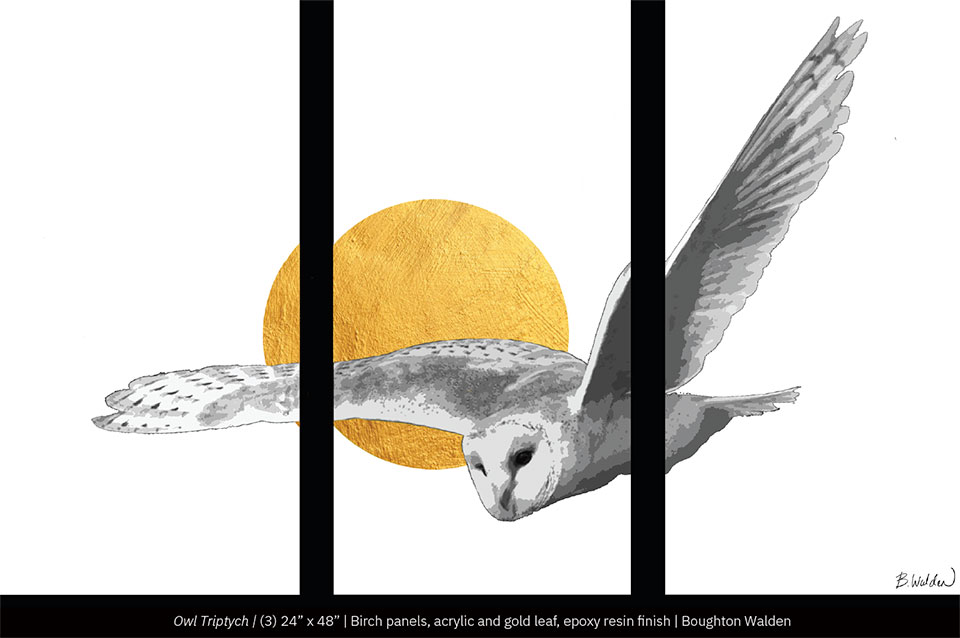Art in Jackson Hole
by Sabina Dana Plasse
Inspired by Tradition for a Modern World Western Artists Offer New Works With Historical Meaning
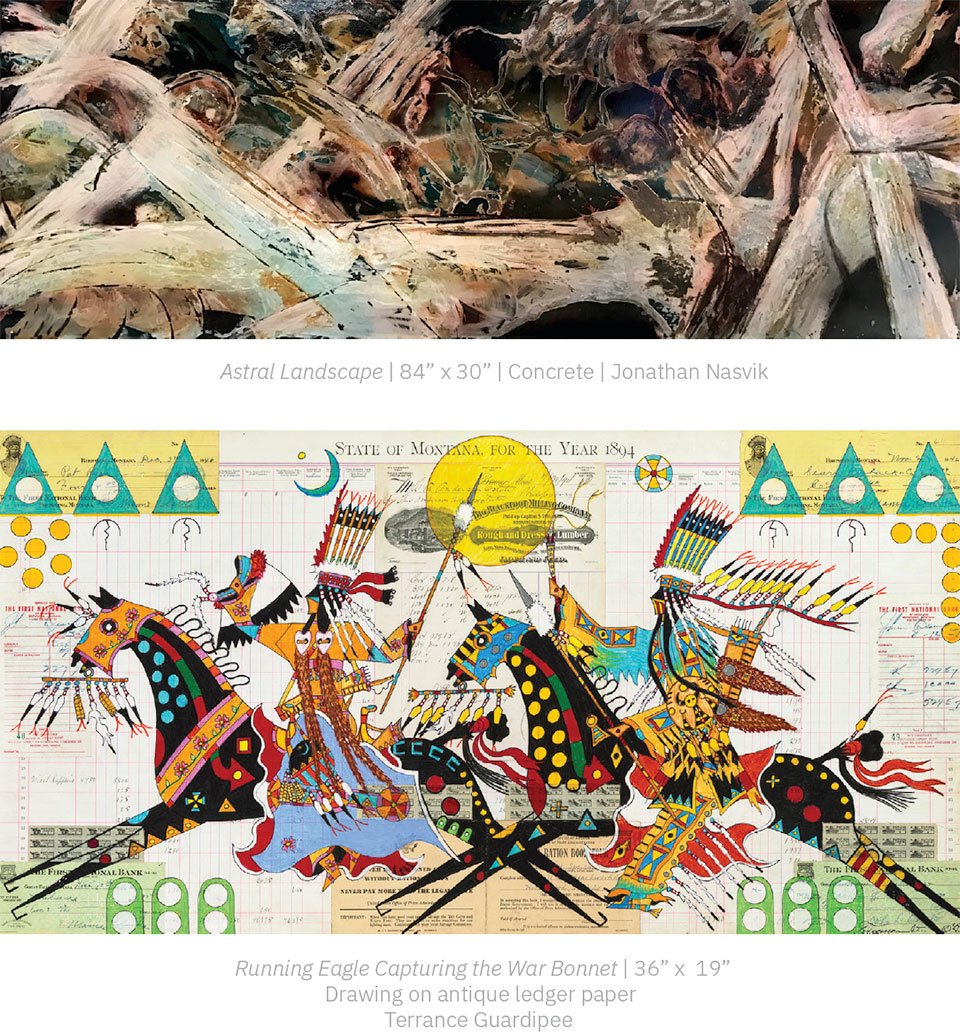
The work of Jackson Hole painter Boughton Walden, Concrete artist Jon Nasvik, and Blackfoot painter and ledger artist Terrance Guardipee, represent an appreciation for Western tradition. Their use of archival imagery and artifacts conveys a particular reverence for the heritage of the land and its people. Discover unique and dynamic paintings on birchwood, beautiful storytelling through authentic ledger art, and the boundaries of concrete that reveal a workingman’s life in the rugged mountains. With a desire to share their perspectives, Western Home Journal presents three artists who create authentic and original art in their chosen mediums that inspires and portrays a sense of time and place in the Mountain West.
A Moment in Time
Contemporary Western Artist Boughton Walden
The work of contemporary western artist Boughton Walden is alluring, embodying a 21st-century style and appeal with a sense of history. Originally from Charlotte, North Carolina, where she also studied at the University of Alabama, Boughton arrived in Jackson Hole, Wyoming, and embraced the landscape and flora/fauna as her own.
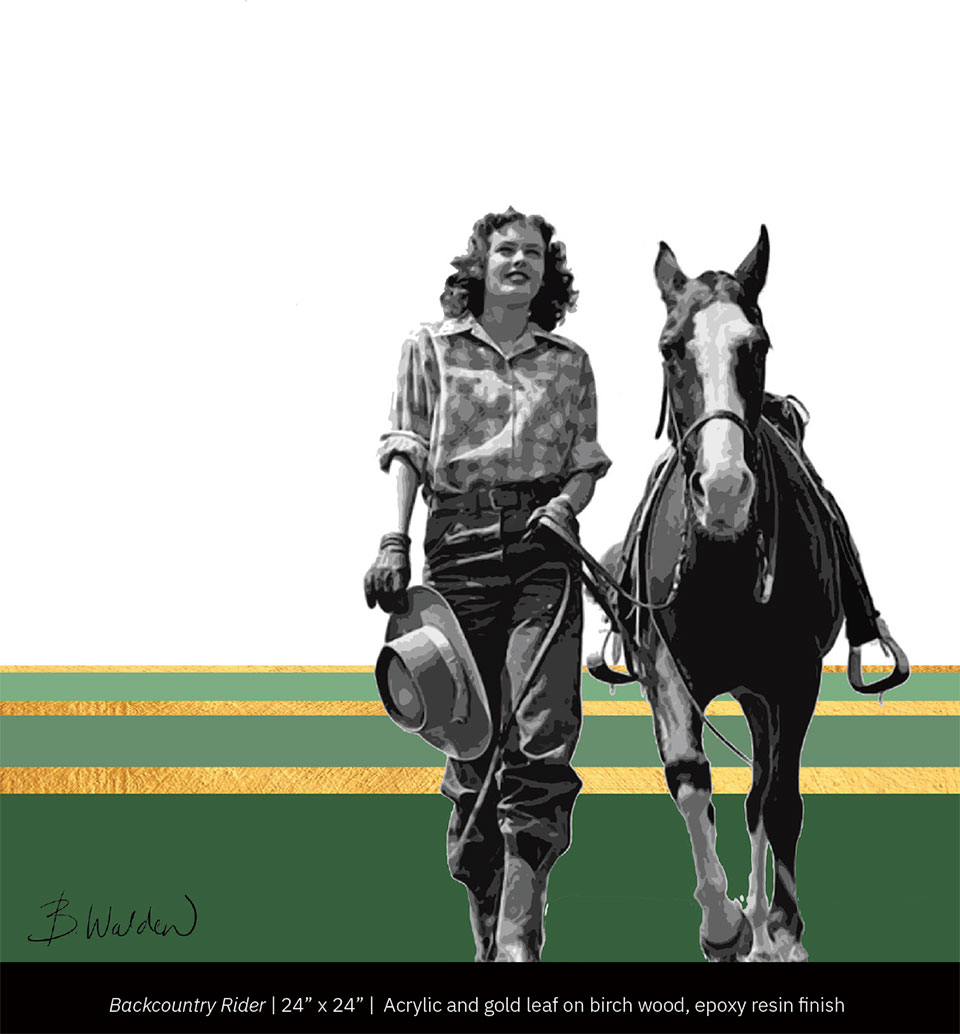
“These images reveal a story that I want to capture but also be able to modernize. It all tells a story, but it is my interpretation vastly different from people who have experienced it before me.”
–Boughton Walden, Artist
With a background in graphic design, Boughton looks to her art studies and technology knowledge to inform her work. She also hand-paints selected images with backgrounds, horizon lines, and foregrounds. She is creating a moment in time that is present and historic. With a digital rendering and on birchwood canvas, Boughton’s subjects come to life through a process of sanding, priming, drawing, and painting.
“It’s a free and creative process to work with an image before paint hits the canvas,” she says. “What happens on the birchwood canvas is the execution of the painting. When it’s finished, the epoxy resin finish I pour on top provides a thick gloss, adding a third dimension to the piece.”
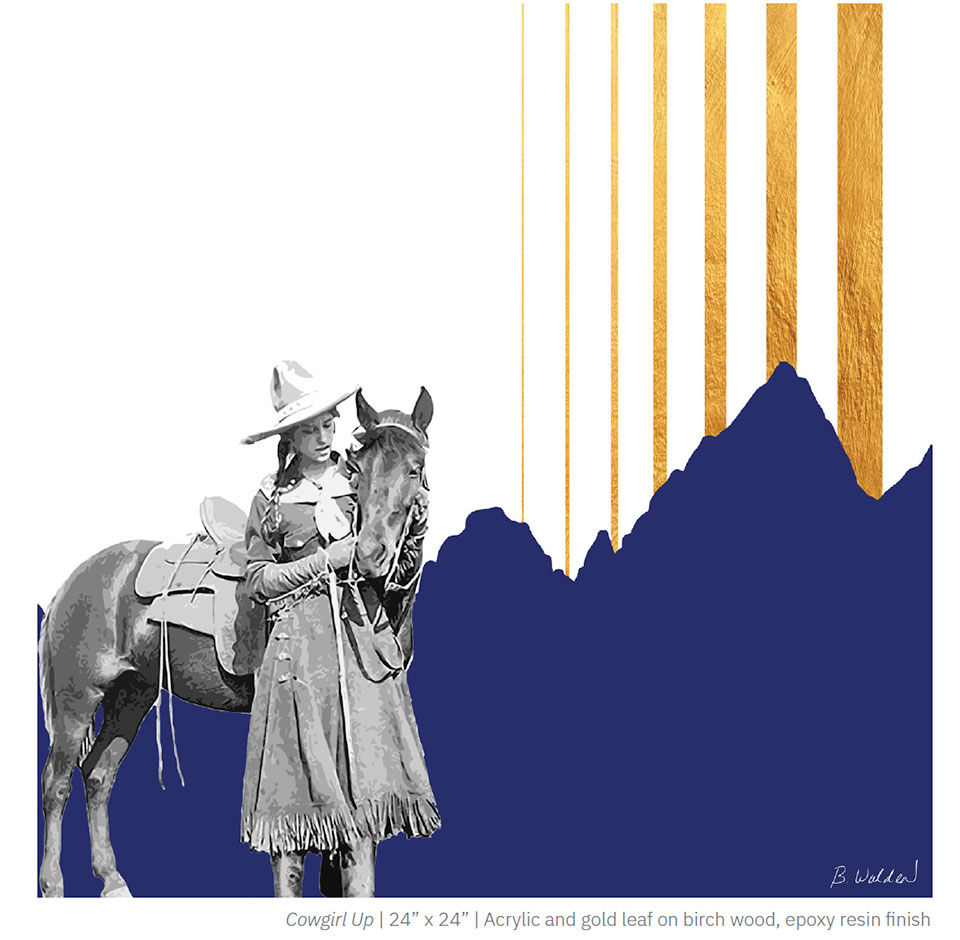
Taking tradition and combining it with a modern process to make it contemporary, Boughton presents new work from archival images using her love of western scenic landscapes and topography while utilizing filters, textures, colors, and other design tools. “It’s an enormous benefit to my creative process to work with my computer like a team member,” explains Boughton.
Embracing black and white as well as a careful use of color, Boughton can capture her subject matter within her design intentions while offering a new perspective to traditional western art, which often tends to be less energetic in color and style with mostly browns and taupes. “To focus on one subject, I can present the beauty and freedom that exists, taking it out of its traditional landscape and giving it a new background,” she shares.
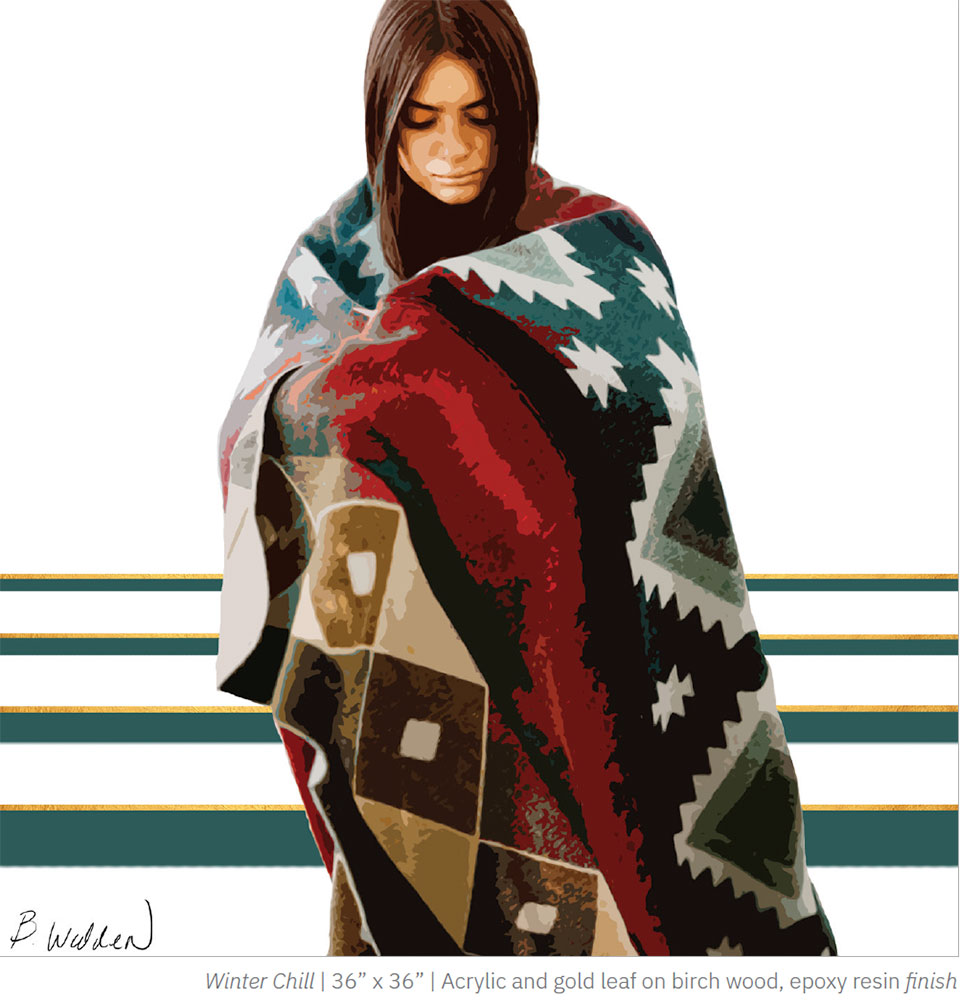
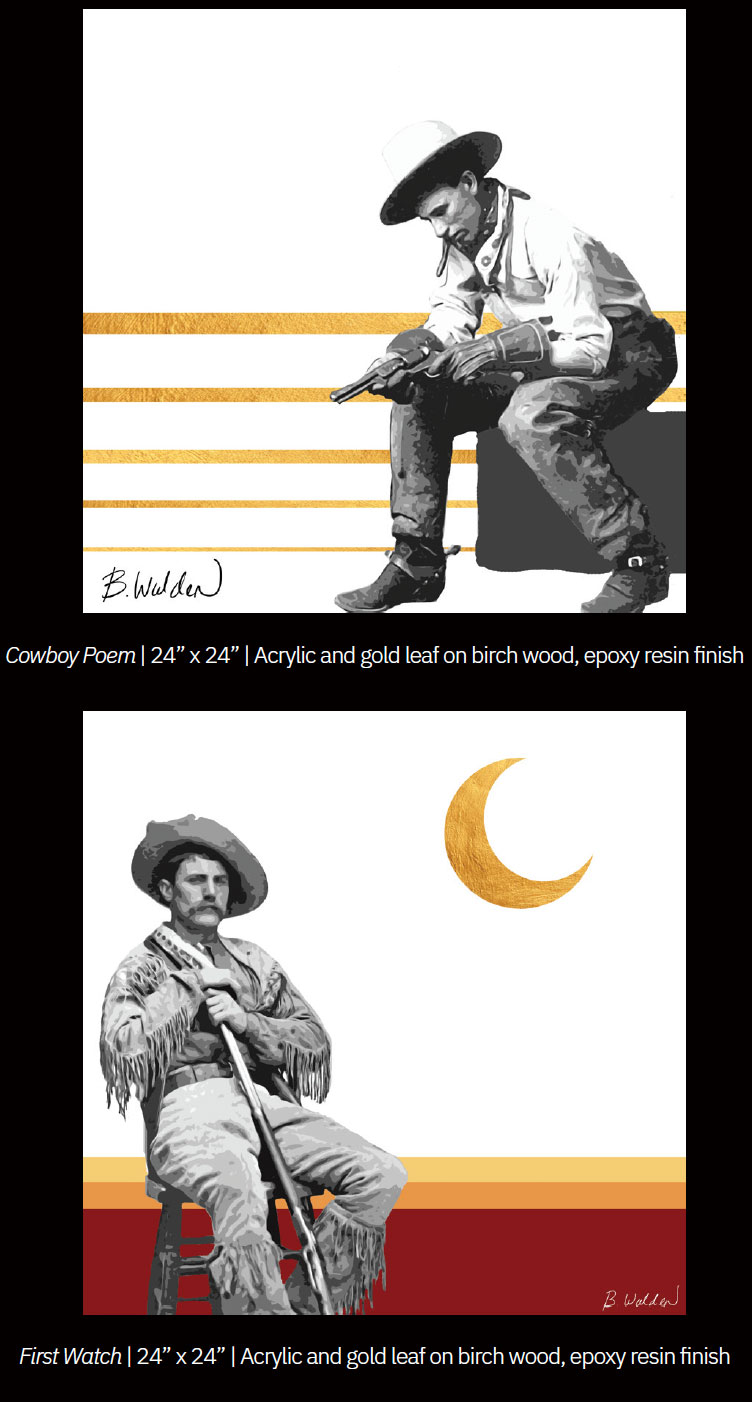
Backcountry Rider and Cowgirl Up offer examples of Boughton’s new perspective on tradition, as she provides archival imagery in a modernized landscape. She expresses an admiration for the many aspects of living in Jackson Hole, Wyoming, including all of the wildlife as well as a deep and rich history. Researching archival imagery of old settlers and people in this area of the Mountain West also offered Boughton a fresh approach to her vision of the West.
“These images reveal a story that I want to capture but also be able to modernize,” she says. “It all tells a story, but it is my interpretation—vastly different from people who have experienced it before me. I wanted to show how differently it existed. In Cowgirl Up, I thought about a girl living in the mountains and being part of a riding troop with no modern amenities. Her experience was very different from ours.”
The beauty of a Pendleton blanket and the essence of Native American art is also exciting to Boughton, as is the wildlife, which has never changed, yet Boughton’s Owl Triptych gives an owl new energy and focus. The question of survival and existence is apparent in these new works but each one creates a sense of modern beauty through color, texture, and technique.
Boughton’s original works offer a conceptual, contemporary feel embodied with a sense of tradition and respect for the West. “These generations and generations of learning experiences are an art form of their own,” says Boughton. “It’s beautiful that Native Americans and others could survive here with only what was around them. It opens a new window for me and the art I want to create. I want to show how much has come before us and the simplicity of history that is important to living in such a beautiful area.”
Boughton Walden Fine Art original works are on exhibition at Local Restaurant & Bar in Jackson Hole, Wyoming, ArtShop in Moose, Wyoming, and Old Main Gallery in Bozeman, Montana.
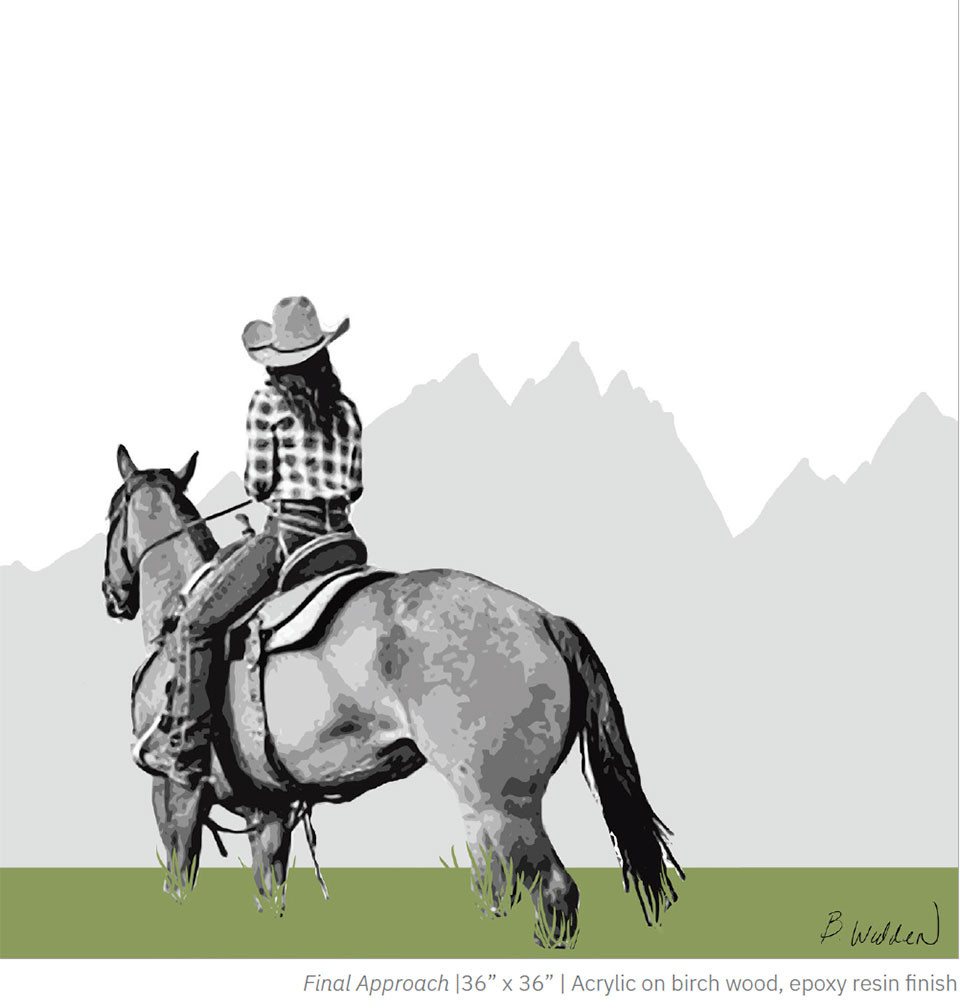
The ArtShop, Moose WY
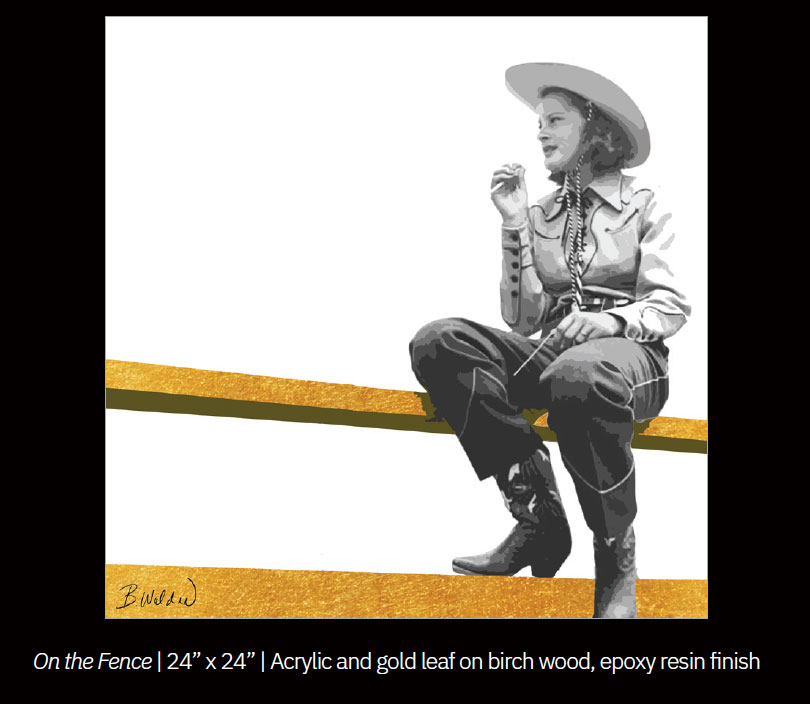
As a supporter of local artists, the ArtShop in Moose, Wyoming, also presents Boughton Walden Fine Art. The ArtShop’s mission is to showcase and sell local art. The ArtShop values the creative process, time, and skills it takes to create unique pieces while supporting artists throughout the Jackson Hole, Wyoming, community. The ArtShop allows visitors and locals to collect local art while supporting local artists of all disciplines.
12170 Dornan Road, Moose, Wyoming- artshopjh.com
Boughton Walden Fine Art: kbwalden@gmail.com boughtonwalden.com 704.953.0153
Evoking the Spirit of Art
Jonathan Nasvik gives concrete an artist’s touch and vision
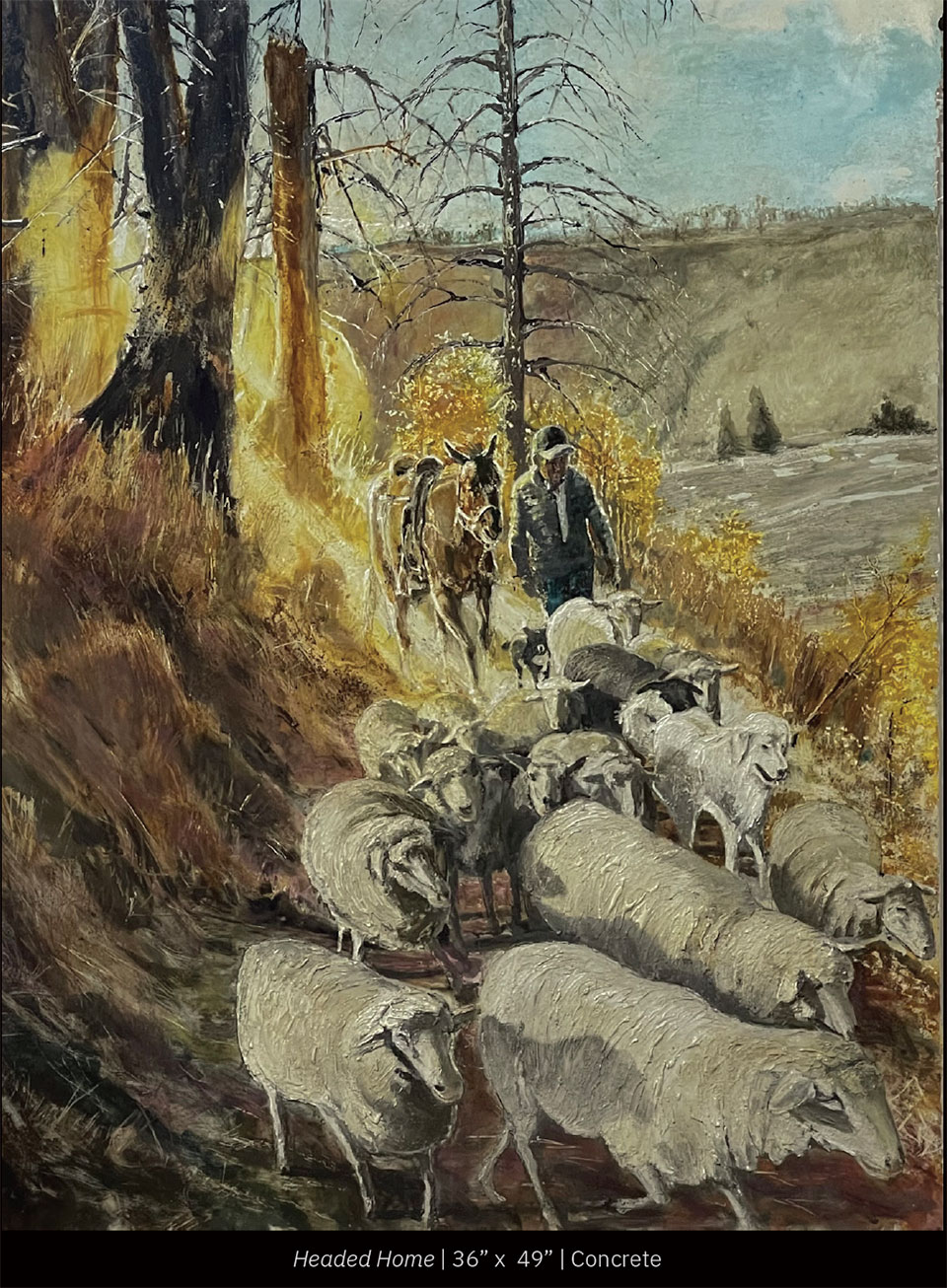
Jonathan Nasvik, a lifelong artist, knows, understands, and revels in concrete, which, for him, has never gotten old but continues to fascinate instead. It is his passion to use concrete, an ancient and common building material initially developed by the Roman Empire, in an entirely unique way.
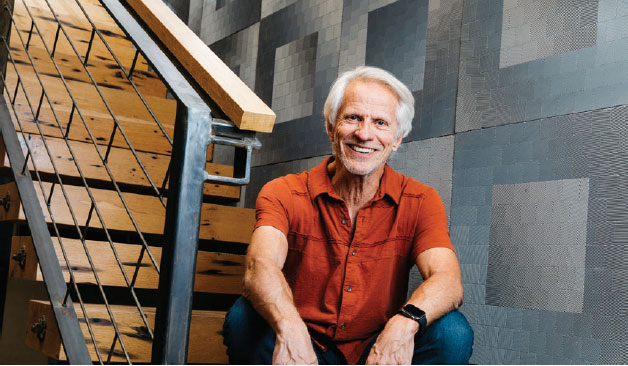
“I like the idea of representing local art. This is Idaho, where I find a great deal of my inspiration in its natural beauty.”
–Jon Nasvik, Concrete Artist
“Art is not easy for me,” says Nasvik. “It’s a process that involves a fair bit of time to think about, plan out, and lay down, made real from a series of feelings, ideas, and anxiety that often churns up in my head for weeks before mixing any colored pots of concrete. When that happens, I get excited and critical with every new layer of shape, color, texture, and expression that evolves into reality with every new project.”
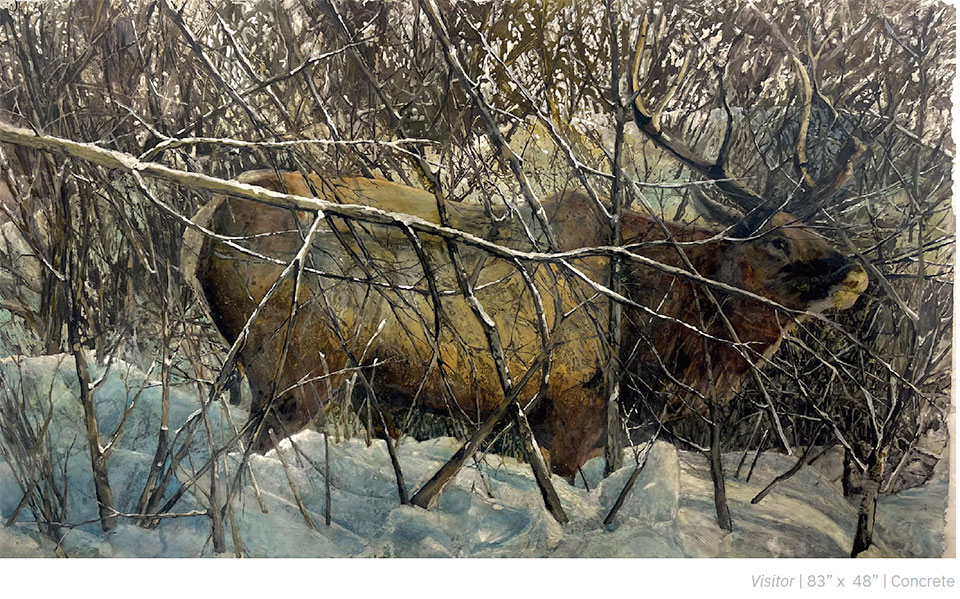

One of Nasvik’s most recent works, Headed Home, evolved from a late-afternoon autumn hike at peak foliage with his wife and daughter. Capturing the sunlight through a pine tree, he was inspired by the golden light that outlined his wife, daughter, and other objects along his hiking route.“My interest in light and color from this particular hike inspired me to create a scene with a sheepherder with his horse, dogs, and a group of sheep, which is what can be found along many Wood River Valley hikes in the mountains at this time of year,” Nasvik says. “I like the idea of representing local art. This is Idaho, where I find a great deal of my inspiration in its natural beauty.”
“You’ll notice that the original layout is backwards. Thats because the painting is technically a casting where the image is made with layers of colored concrete applied over a sheet of melamine until it is about 1/8” thick And then, after it hardens I peel it off the melamine and flip it over to reveal the reverse version. Kind of like making a print.”
–Jon Nasvik, Concrete Artist
As an artist working and living in the 21st century, Nasvik senses that climate change affects his feelings about the here and now. It’s more beauty than recollection because he feels he could be looking at some aspects of nature for the last time, so he wants to capture what he can in his chosen art form. “I am inspired to present this or at least record it,” says Nasvik. “I want to enjoy it because it is here and shouldn’t be forgotten.”
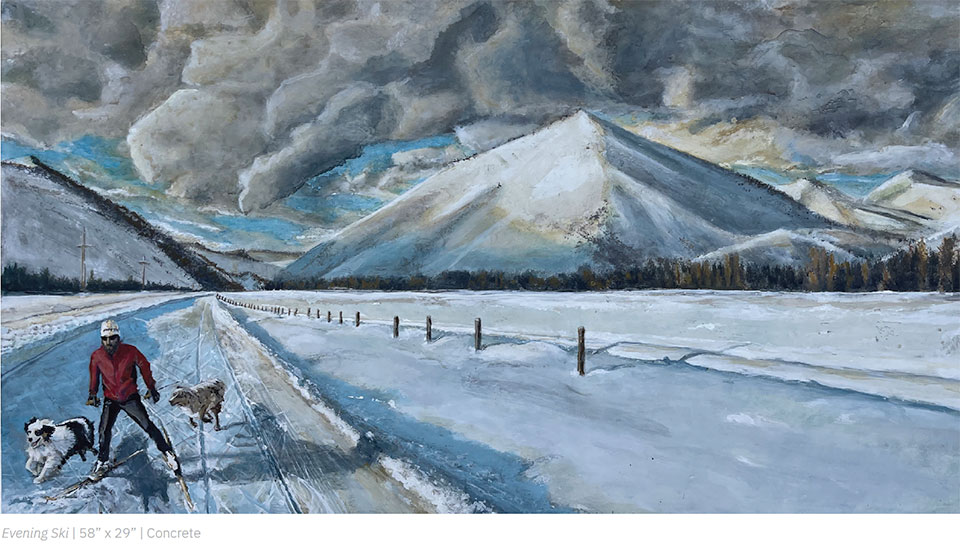
Nasvik’s focus and vision for his artistic endeavors in creating his original pieces usually begin as a backward layout. It’s because the “painting” is technically a casting and the image is made with layers of integrally colored concrete applied over a non-stick surface until it is about an eighth of an inch thick. Each new layer hides portions of or all of the previous layers, which is perhaps the most fascinating element of Nasvik’s form and function in his concrete art because, at some point, he is no longer able to see it.
“It becomes a mystery,” he says. “So, after it hardens, it is lifted off the non-stick surface and flipped over to reveal itself for the first time; it’s like opening a surprise package. It can be exciting, just right, or it can take me down a new path. It can also reveal big mistakes, often good for learning and improving my ability.”
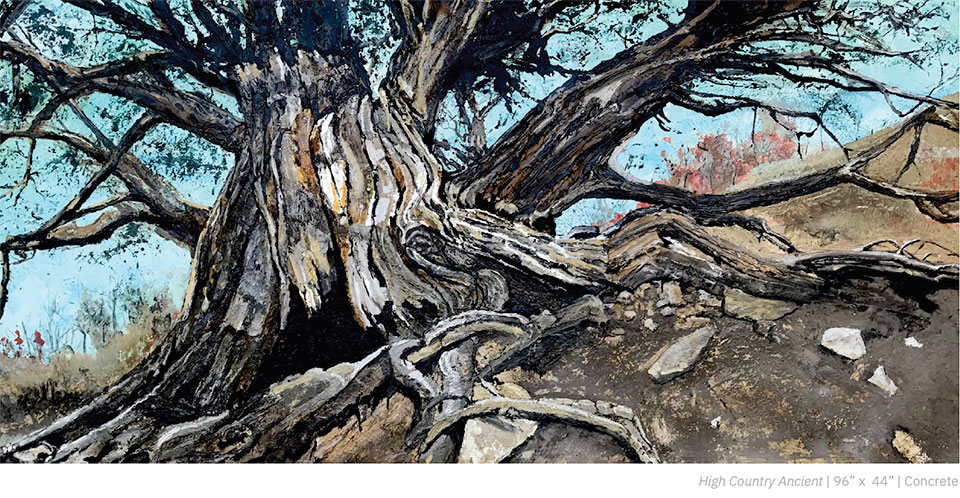
Recently, Nasvik created artworks to be more like wall hangings rather than big mural pieces or wall installations, cutting down the thickness to an eighth of an inch and embedding an aluminum channel along the backside of the art so it will hang securely. Still, the edges are undefined, as seen in Visitor, and the work is a manageable size at three feet by four feet, offering many options for exhibition. “It flaps like a piece of fabric when you grab a corner and shake it,” describes Nasvik, which is quite different from his earlier thicker and heavier pieces.
“Concrete decides what it wants to be, which is not always what one might think.”
–Jon Nasvik, Concrete Artist
However, the style and feel of Nasvik’s work continue to be unique, allowing a subject to appeal with flow and smoothness. It can have a texture that is hard to come by in any other medium, and it provides detail and color that is strong and inviting. It often causes a double-take because it’s so captivating and difficult to believe that it is concrete. Lending to the abstract, Nasvik enjoys the element of the unknown that is connected to working in concrete, which he continues to explore as an art prospect.
“Concrete is very versatile. It’s impossible to get past learning from it,” he says. “It is a material many people ignore, and interpretations vary. It has many of its own natural colors and moods. It can be monochromatic or very busy. Concrete usually decides what it wants to be, which is not always what one might think.”
Nasvik has devoted much of his life to understanding concrete and its versatility and perception. “There’s something very appealing about allowing a material to express itself in its most natural way,” says Nasvik. “This is what I like about concrete, how it lends itself. It can be anything by simply being itself, and I’m always interested in exploring this, which is why I love producing the art with it.”
Providing a Presence for History
Blackfeet ledger artist and painter Terrance Guardipee discerns his workn
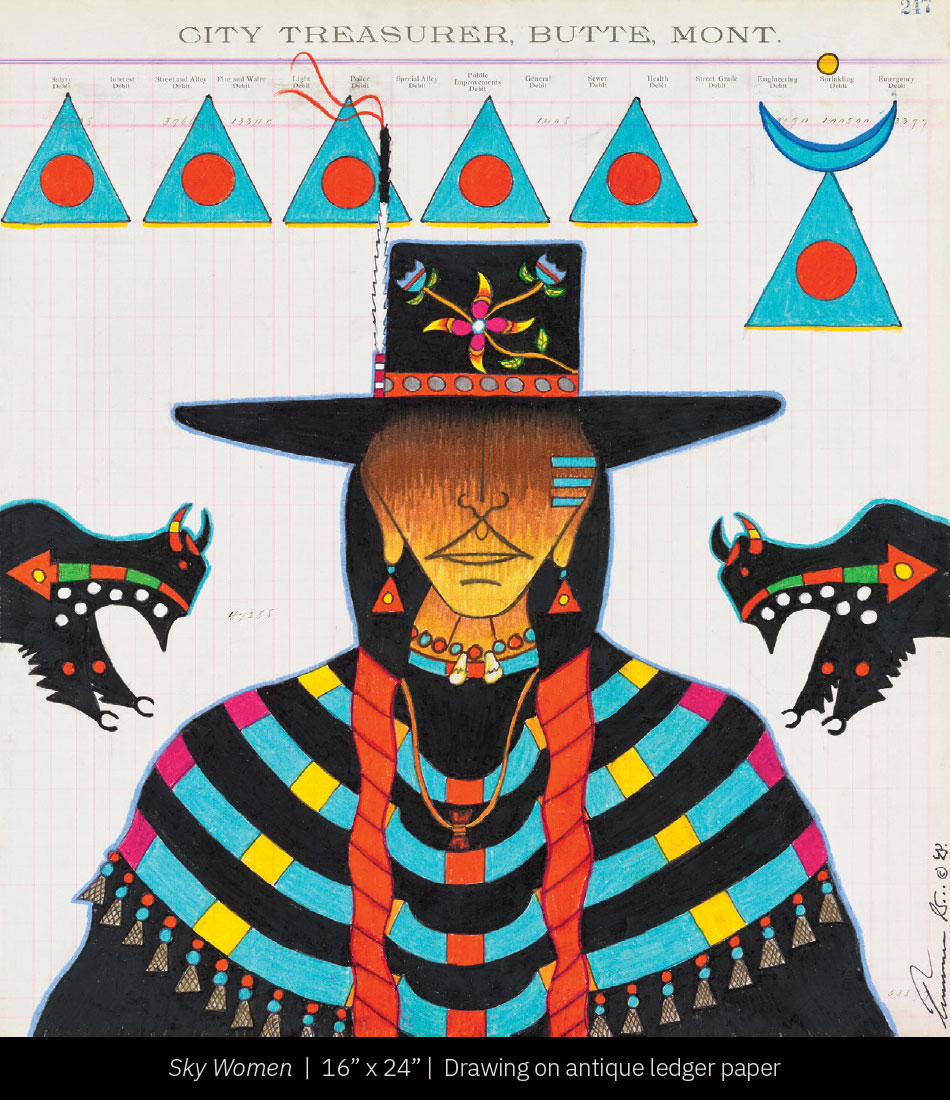
The intrigue surrounding ledger art as a traditional art form for Northern and Southern Plains Tribes is a connection to a tribal past, a lens to generations of storytelling, tradition, and heritage. For Terrance Guardipee, ledger art is a voice for the past in the present.
“The ledger art form is important to me,” explains Terrance. “But equally as important is the message in my art.” Evolving from historic hides, muslins, and ledger books, the history of ledger art as a narrative artistic form can be traced back to Native nations from the Great Plains. Bringing the past forward through his art, including original ledger paper, checks, receipts, war rations, or any document that Terrance was able to acquire with meaning, added to his craft.
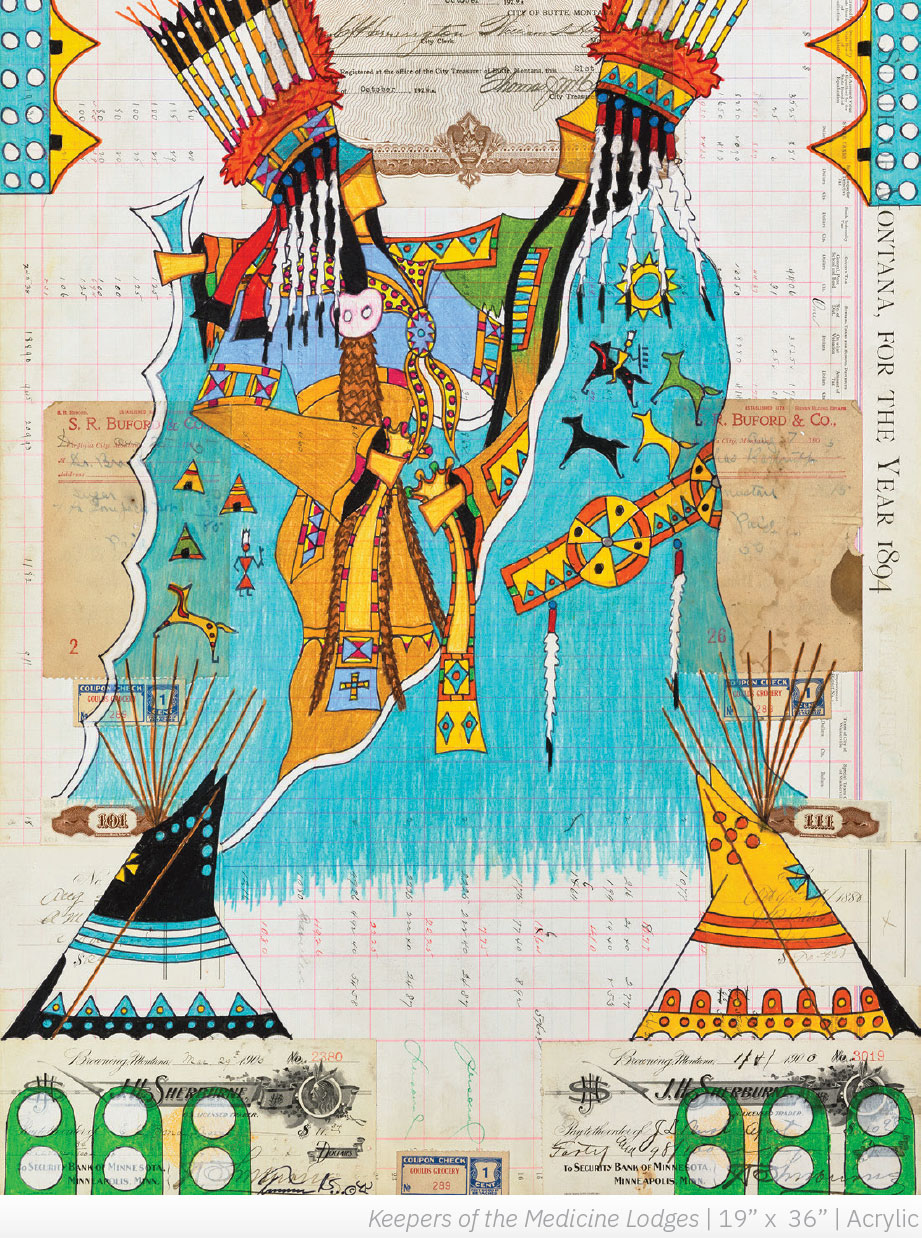
“I had known about ledger art and was drawn to ledger art through art school, being interested in Native art,” says Terrance. “My mentor, George Flett, was a Spokane tribal member. He became my good friend, along with several others doing ledger art. There was a desire to bring ledger art back to life, onto the bigger stage, and to the Indian market.”
Terrance joined a group of five ledger artists, including George Flett, Dwayne Wilcox, Jim Yellowhawk, and Donald F. Montileaux. They all worked together to build a foundation for the resurgence of ledger art in the contemporary art world.
“We were doing shows and pushing this style of art around 1998-2004,” he says. “Each of us was on our path. I came up with my style and version of ledger art. I started using gas station maps. Eventually, my character grew, and I could show where I was from. When I acquired large ledger paper circa the 1880s-90s, about 36” x 19”, it was the largest I ever had.”
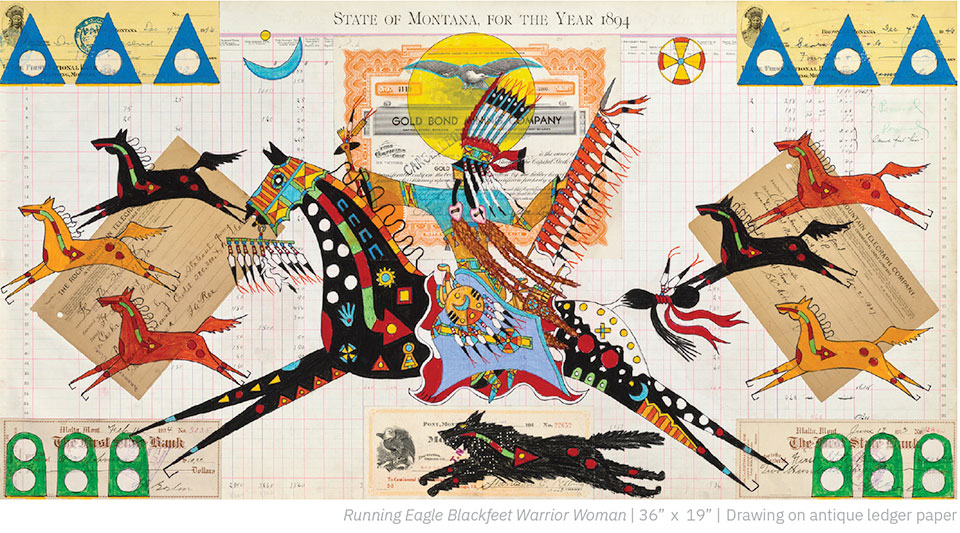
“People see many different things in ledger art, and I want the feel of original works, but with a modern twist in the colors, shapes, and figures I use.”
–Terrance Guardipee, Artist
A constant collector, Terrance has acquired several sizes of ledger paper, offering a variety to collectors along with different collage elements of books and documents allowing him to work with many other materials. “It’s not just me doing everything. I concentrate on the art,” he says. “My daughter and wife help with many other parts needed to run the business aspects of my artwork.”
Perhaps the most attractive element of Terrance’s ledger art, besides the dynamic and color-saturated illustrations, designs, symbols, and characters, is his authenticity toward the subject matter and his process.
“I am not reinventing anything,” he says. “I’m not trying to change what was created by my people thousands of years ago. My art is being created inside and out of my spirit, soul, and mind. I see myself as a Blackfeet. People see many different things in ledger art, and I want the feel of original works with a modern twist in the colors, shapes, and figures I use.”
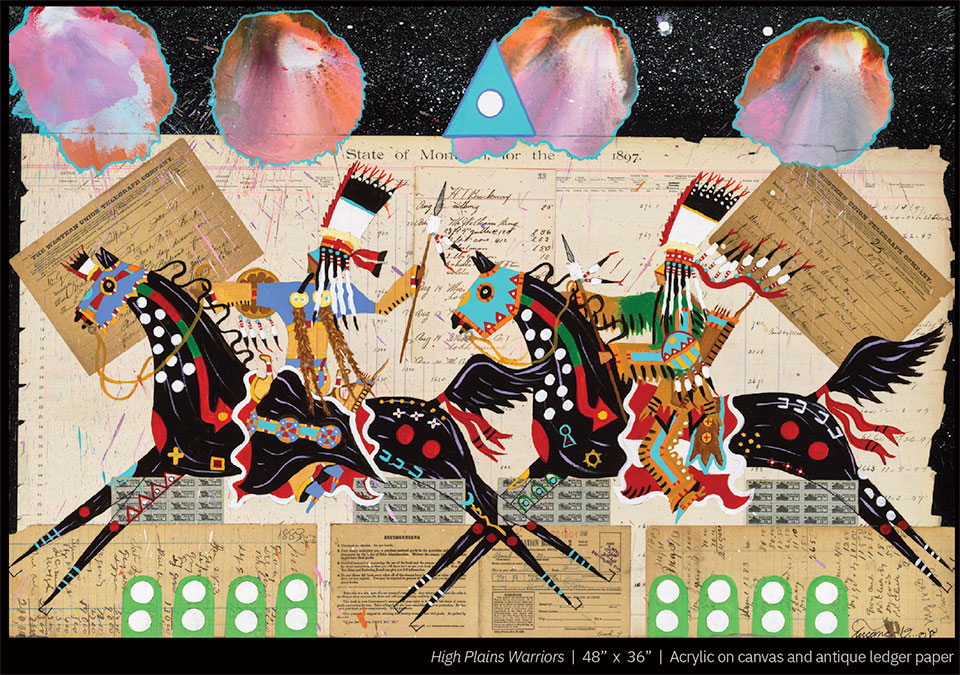
“I’m not trying to change what was created by my people thousands of years ago. My art is being created inside and out of my spirit, soul, and mind. I see myself as a Blackfeet. People see many different things in ledger art, and I want the feel of original works with a modern twist in the colors, shapes, and figures I use.”
–Terrance Guardipee, Artist
Beyond the artifacts intrinsic to ledger art, Terrance also includes specific design aspects from his Blackfeet tribe. He is an enrolled member of the Blackfeet Nation of Montana and illustrates his experience of Blackfeet culture in combination with his educational background in his artwork. Terrance participates in the traditional Blackfeet ceremonies he often depicts in his painting. He attended the Institute of American Indian Arts (IAIA) in Santa Fe, New Mexico, where he studied two-dimensional arts. His educational experience at IAIA enabled Terrance to incorporate the contemporary color palette he is known for in a manner consistent with Blackfeet tradition.
“I cannot speak for other tribes, but Blackfeet have cliff drawings or pictographs on rocks and buffalo robes with drawings on them called winter counts. I use the designs of war, journeys, and visions in my art that are specific to the Blackfeet. I know what they mean and how they were used. I took the time to research them and spoke to elders to learn about the symbols, what they mean, and how they were used—particularly the protecting symbols, which I place especially on my horses. When people purchase my art, I give them the option to use their phones to video, and I explain the piece to give an understanding of what is going on in my art. These videos have become very much like a business card.”
The innovation Terrance has demonstrated in his artwork has been internationally recognized by numerous museums, shows, and private collectors, including the Smithsonian Institute, the Gene Autry Museum, the Hood Museum at Dartmouth College, and the Museum of Natural History in Hanover, Germany. He was the featured artist at the National Museum of the American Indian in 2007 and was selected to create an image for The Trail of Painted Ponies at the 2008 50th Anniversary Heard Museum Indian Art Market. In 2008, Terrance was awarded first place in his category and best of division at the Santa Fe Indian Art Market. Terrance has placed first in the ledger art category at Santa Fe Indian Art Market numerous times since the category’s inception in 2008.
To learn more about Blackfeet ledger artist and painter Terrance Guardipee, visit his website at terranceguardipee.com, and follow him on Instagram at @terranceguardipee.
